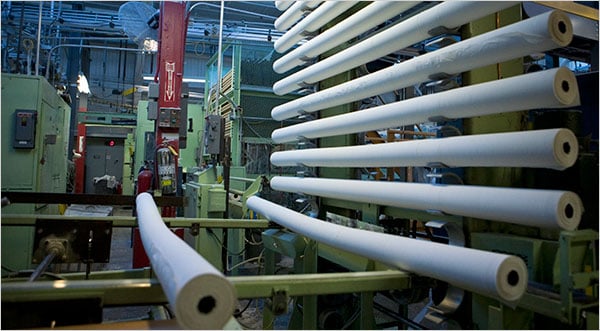Toilet paper today is mostly manufactured from a "chemical pulp," but it all comes from paper. Forms of paper used in the production of tissue paper can include various forms of recylced paper, virgin tree pulp, as well as hemp plants. The main materials used to prodcue toilet paper include:
- Water
- Tree Pulp
- Chemicals for extracting fiber
- Bleach (e.g. choline diozide)

Photo Credit: Juan Arredondo for The New York Times
To give the toilet paper it's pure white color companies use various methods to achieve this including ozone, peroxide, oxygen and/or sodium hydroxide. After that, the tissue paper is often pressed, embossed, scented, perforated, and/or colored.
Using Trees to Make Toilet Paper
Did you know that manufacturers don't just use any and all trees to make paper? It is actually a process of using both hardwood and softwood from "virgin" trees. The combination of hardwood to softwood is approximetly 30% softwood and 70% hardwood.
General Steps:
- Preparation: The trees are stripped of all their bark with a machine that tries to leave as much wood as possible.
- Deconstruction: The remaining wood is then passed through machines to chip them into small pieces and seperated into batches.
- Digestion: A massive pressure cooker cooks the wood chips with other chemicals for aproximately 3 hours. The moisture in the wood is evaporated and reduced to a mass that consists of lignin, fibers, cellulose, and other substances. The end result os the creation of "pulp," a maluable and usable fiber that paper is made from.
- Cleaning: The pulp then needs to be washed clean and bleached until all the color is removed. The adhesive that binds the fiber (called "lignin") together must also be removed from the pulp or it could paper yellow over time following production.
- Pre-Produciton Pressing: The pulp is mixed with a large amount of water to produce paper stock (99.5% water and 0.5% fiber). The paper stock is sprayed onto screens of mesh that drain the water. The paper is then pressed and dried to a final moisture of about 5%.
- Production and Rolling: The paper is scraped off with metal blades and wound onto jumbo reels. It is then moved to machines that cut it into long strips and perforated into squares.
- Cutting: Toilet paper logs are then cut into rolls along the production line, while "miss rolls" or defective rolls are syphoned off into a tissue log shredder. Final rolls are wrapped into packages and then shipped!
Recylced Toilet Paper Production
If the toilet paper is made from recycled paper it beings by mixing several different kinds of used paper being mixed and mashed together. Then next step which is critical to recycled toilet paper production is using a process to de-ink or discolor the used paper. Companies will use various forms of solutions to do this, but it all needs to be washed and deinked prior to being pulped. It is then pulverized and reformed into a very thin and soft paper, ready to then be bleached, scented, etc.